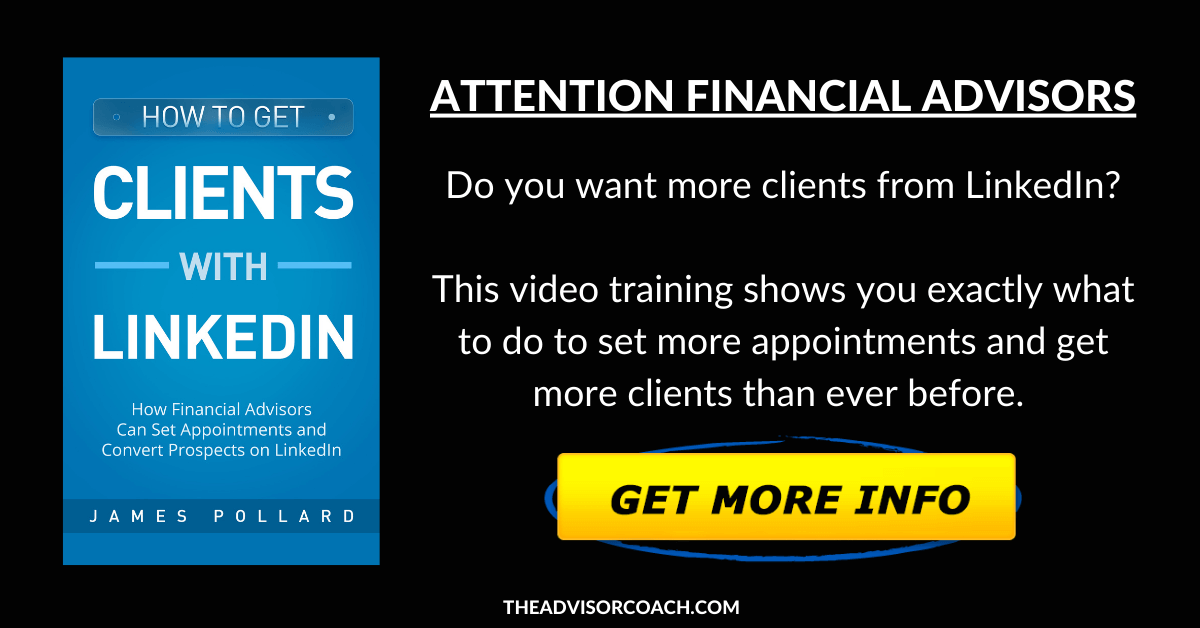7 Awesome Tech Tools for Financial AdvisorsThis post may contain affiliate links.
If you’re a financial advisor who is serious about building your business, you need to leverage every possible advantage you can get in the marketplace. Right now, technology offers a huge advantage. The advisors who get comfortable using technology are the ones who are going to survive and thrive in the new digital economy. I’m not saying that you should go 100% digital, but it does help to have some tech tools in your tool belt. Again, the idea is to use every advantage you can get. However, if you haven’t invested hundreds of hours using various tools (like I have), finding exactly what you need to use can be overwhelming. I’ve found that one of the biggest pain points for financial advisors who want to get more clients often revolves around technology. That’s why I’m going to share with you my favorite tech tools that I actually use. I have used dozens and dozens of different tools and I recommend these for a reason. But first, I have a warning….
If you’re busy running your business, and you feel as if you don’t have the time to use these tools yourself, you should absolutely outsource it. But you should never outsource a crucial piece of your business if you know nothing about the process. I want you to become at least somewhat familiar with what’s going on. Think about it this way: I use an accountant to look over tax-related items, but I’m not naive when it comes to taxes. While I don’t know nearly as much as he does about the specific stuff, I know enough to know whether he is doing a good job. The same goes for tech tools. You might not need to know every tiny detail about these tech tools, but you do need to know enough to understand how they can help you grow. With that being said, here are my favorite tech tools for financial advisors. 1. Client Relationship Management Software (CRM)
Repeat after me: “If I learn nothing else from this article, I will learn that I need a CRM.”
You need a CRM. This is basically the software that keeps track of all your leads, prospects, and clients. Unless you want your business to stay small for all of eternity, you can’t possibly keep track of everything in your head. Once you’ve got a few dozen prospects in your pipeline, running your business becomes infinitely easier with a CRM. In the CRM, you can keep all of their contact information (phone, email, mailing address, etc.) as well as notes from your previous contacts. You can log into your CRM and see the last time you spoke to a particular person and what you talked about. The best financial advisors I’ve ever seen live and die by their CRMs. It stores everything from favorite restaurants to kids’ birthdays. Imagine sending out a quick email to wish a client’s child a happy birthday. How would that set you apart from everyone else? When it comes to CRMs, I personally recommend Capsule. Every so often I will get a financial advisor asking me why I recommend this particular CRM. There are two big reasons: it’s cheap and it’s easy to use. I recommend Capsule because even the most technophobic financial advisor can make use of it. I’ve found that since some financial advisors don’t even use a CRM in the first place, offering an expensive or complicated solution scares them away. It’s like this - if someone has never exercised a day in his life, would you start off with heavy squats and deadlifts? Of course not! You’d go with something a little easier. If you give the person a 315 lb. barbell on his very first day, he won’t ever come back to the gym. Hopefully, that makes sense. I actually wrote an entire review about Capsule here: The Best CRM for Financial Advisors 2. Website Builder
Let's get real: people expect you to have a website by now.
When consumers are looking for a financial advisor online, if you don’t have a website, they can’t consider you because they’ll never see you. And if you are doing outbound marketing, people will want to look at your website to form a solid impression of you and your business. If you don’t have one, you’re letting them down. Plus, your website is the employee that works for you 24/7 and never gets tired or calls in sick. It is always there, ready to talk to prospects and provide them with valuable information. If you don’t have a website, you need one. But as we saw with the CRM, the financial advisors who stray away from technology because they think it’s too expensive or it’s too complicated. Enter: Weebly. Weebly is a drag-and-drop website builder. Can you click on something and drag it across your computer screen? If so, congratulations! You are officially qualified to use Weebly. Are there other options out there to build a website? There sure are, such as Wordpress, but Weebly has proven itself easy to use, the designs are beautiful, and the customer service is great. Note: if you ever want help with your website, make sure you hire a marketer (like me), not a designer. Designers want things to look pretty. Marketers want things to make money. There’s a big difference. I’ve seen financial advisors invest many thousands of dollars into a beautiful website that doesn’t convert. ALSO READ: 7 Reasons Why Most Financial Advisor Websites Are Terrible 3. Email Capture Form
Once you’ve got your website up and running, you need a way to capture email addresses.
Let me make this perfectly clear: if you aren’t capturing email addresses, you are leaving money on the table. Something like 98% of all your website’s visitors (and that’s probably a low figure) will leave without taking any action. If you’re anything like the majority of financial advisors out there, your website isn’t getting tens of thousands of visitors per month, so you should make the most of what you have. That’s why you need a way to capture email addresses, and I personally recommend OptinMonster. It allows you to create opt-in forms and have them on your website in a few minutes, ready to collect email addresses. Ever since I’ve been using OptinMonster, my email list has been growing faster than ever before. I’ve also been using their A/B testing functionality to increase my conversion rates over time. I’m constantly testing these opt-in forms to get the most performance. Let’s say version A gets 2% of all visitors to opt-in, while version B gets 3%. I will stop running version A and start testing another version (version C) against version B until I get even more than a 3% opt-in rate. Split-testing is just like compound interest. For example, if you increase your conversion rate just 5% per month, you will have given yourself an 80% lift over the course of a year. Imagine giving yourself an 80% raise - that’s what it’s like. I wrote an entire review of OptinMonster here: Why I Love OptinMonster You just need to have a way to build your email list. Once you have that big email list, you will need to use the next tool…. ALSO READ: 19 Tips to Improve Your Email Marketing as a Financial Advisor 4. Email Marketing Automation Software
This whole thing is a process. If you have a website, awesome email capture forms, but no way to follow up, you will fail here.
But if you’re running a business, you probably don’t have time to sit around all day and write emails. That’s why you need email marketing automation software, also called an email autoresponder. An autoresponder is a sequence of emails that are sent automatically to people who have opted into it. The same emails go out, in the same sequence, for every subscriber on your list. Of course, with this software you can still manually type and send an email (called a “broadcast”) but the idea here is that you want your business to be as automated as possible. To give you an idea of what might happen in an email autoresponder sequence, here is a sample:
This can go however you set it up and continue for as long as you have it set up. I personally use Drip for my email marketing automation software. Check out my review of Drip right here. With Drip, you can set up a rule where if someone does X, you do Y. So if someone sets an appointment before day 11, you can set it up so they will never get that appointment email. Or you could always take them out manually. Either way works just fine, but I prefer automation. I really like the ability to split-test my emails (I test everything). Wouldn’t it be nice to know which subject lines perform the best for you? Suppose subject line A got 20% of your list to open while subject line B got 40% of your list to open. If you never test your emails, you are making it harder on yourself. With Drip, you can also see if someone opened your emails. That’s cool because if the person doesn’t open your email asking for an appointment, you can just send another one, perhaps with a different subject line. The idea is that this machine is working for you nonstop, keeping your name in front of your prospects and asking for appointments. ALSO READ: 7 Awesome Content Marketing Tips for Financial Services 5. Online Scheduler 🔥Online schedulers are awesome because they completely eliminate phone and email tag. No longer will you have to go back and forth to find a time that works for both you and the other person.
They’re also awesome because they can easily be inserted onto a webpage or email, allowing prospects to set appointments with you when they’re ready. If you’ve got your website up and running with your opt-in forms and email automation software, that’s great, but eventually, you need to ask for an appointment. Right about now some of you are probably thinking, “Well, can’t I just call the prospect and set the appointment over the phone?” ….no….and here’s why: Your prospect has been to your website. If your website is halfway decent, it will have your phone number on it. That means your prospects have access to your phone number but have chosen not to call you. They have instead given you their email address, and because they haven’t unsubscribed from your autoresponder, they are still interested in hearing from you. It’s best to communicate with your prospects in such a way where they’re comfortable, so email it is (at least in this scenario). Now I should make it perfectly clear that not everyone on your list will set an appointment with you. Actually, I guess it could happen, but the chances of it happening (provided you have a big email list) are extremely low. However, this machine will be running with almost no effort from you after you set it up. It’s like taking a vitamin one time but getting the benefits of that vitamin every day. If 100 people opt-in to your email list, 20-30 might open your emails and 2 or 3 might set an appointment with you. Maybe more, maybe less. But it will work for you and set appointments for you whether you’re sleeping, sick, or on vacation. When you send an email to your prospects, include a link to your online calendar. There’s a bunch of them out there - it doesn’t really matter which one you use as long as it works. I personally recommend Acuity because it’s easy to use and they offer a decent free plan. You can pay for them if you want, but their free plan is probably all you need. Plus, an online scheduling tool will automatically adjust your calendar whenever an appointment is made. So if someone sets an appointment with you at 11 a.m., that time would be blocked off, so nobody else can set an appointment with you at 11 a.m. Having an online scheduler eliminates a LOT of headache from a financial advisor’s day. Once you get used to it, you won’t ever want to go back to the old way. ALSO READ: 7 Reasons Why Most Financial Advisor Websites Are Terrible 6. Social Media Automation Tool
Social media is both a blessing and a curse. It’s a blessing in the sense that it allows to instant communication to masses of people, but a curse in the sense of the time commitment it takes from businesses.
But then again, you can make a LOT of money from social media. Which is why it’s great to have tools like Buffer. Buffer allows you to upload social media content in advance and have it sent out at a predetermined time. It could be 3:00 a.m. and you could upload content to Buffer to share at a time when your audience is more engaged… unless your audience is vampires. Having the tools in place to automate your social media content is another way to get a valuable task done in a very efficient way. Plus, it allows you to consistently be posting content. Imagine having a prospect reach your Facebook page, only to see that you haven’t posted anything in eleven months. How does that make you look? With social media automation software, you can develop consistent content distribution. One thing I really like about Buffer is that it has built-in analytics right in your dashboard, which lets you see what types of content are resonating with your audience, so you can become more effective over time. ALSO READ: 4 LinkedIn Tips for Financial Advisors 7. SEO Software
This is something that isn’t absolutely necessary, but it is nice to have.
Remember how I said that financial advisors don’t get that much web traffic? Well, you can get more traffic than your competitors by creating content that people are actually searching for and then ranking for those terms. For example, if you are a financial advisor in Columbus, Ohio, you probably want to rank on the first page of Google whenever someone searches “financial advisor columbus ohio”. Especially since that exact term gets searched 880 times per month. How do I know that? I used a tool called SEMrush. SEMrush allows you to dig deep into keyword data, competitor research, and even content ideas. You can use its plethora of resources to see which terms people are searching for, how much, and what it takes to rank in Google. Here’s how this can impact your business… Let’s say that you’re ranking #1 for “financial advisor columbus ohio”. Now, not every single one of those 880 searches will click on your website, but about 30% (give or take) will click on the first result. That means your website will get an extra 264 visitors per month or 3,168 visitors per year. Now let’s say that you set up some beautiful opt-in forms from OptinMonster to collect email addresses, and 3% of all your website visitors opt into the form. That means you will collect 95 email addresses per year, who you can keep in touch with and follow up with as you please. 95 email addresses may or may not sound like a lot to you, but keep in mind that’s from ONE search term. Imagine having dozens of articles on your site ranking for valuable terms. You can start to grow a big list, really fast. I wrote a more in-depth article about financial advisor SEO, which shows you exactly what to do. You can read that here: SEO For Financial Advisors: 3 Things You MUST Know P.S. If you're a financial advisor who wants to get more clients from LinkedIn, make sure you check out How to Get Clients With LinkedIn: How Financial Advisors Can Set Appointments and Convert Prospects With LinkedIn |




